July 1, 2025 | 18:27 GMT +7
July 1, 2025 | 18:27 GMT +7
Hotline: 0913.378.918
July 1, 2025 | 18:27 GMT +7
Hotline: 0913.378.918
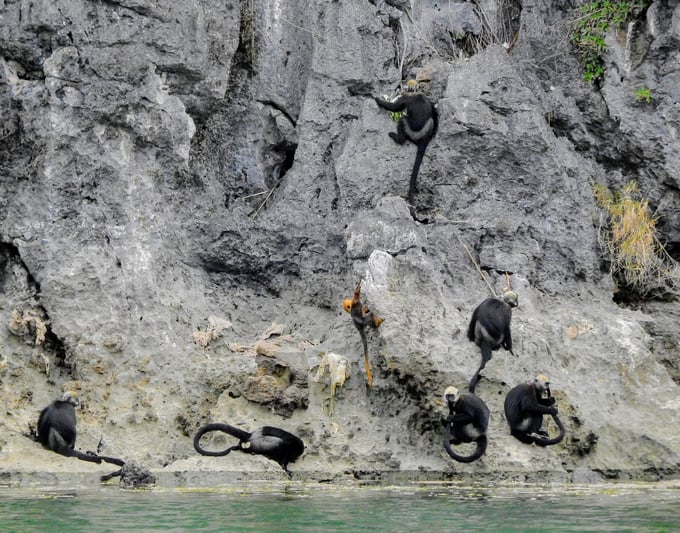
The Cat Ba langur herd has increased to approximately 90 individuals. Photo: Huy Cam.
Informing Vietnam Agriculture Newspaper, Mr. Pham Van Phuc, Deputy Director of Cat Ba National Park, said that from mid-2023 to October 2024, the langur herd at the National Park has increased by nearly 20 individuals. Especially since the beginning of 2024, the langur herd has increased by 15 individuals, bringing the total herd to approximately 90 individuals. This is the largest number of langurs and the strongest increase in the past 20 years.
The reason why the langur herd has thrived again, especially in the past few years, is that Cat Ba National Park, the langur project, and the local government have had many solutions to protect and develop the langur herd. For example, disseminate and mobilize hunters not to enter the forest to illegally hunt wildlife; increase patrols and strictly handle violations.
The strong intervention of functional agencies and the decrease in the number of wild animals have caused hunters in Cat Ba to quit their jobs and switch to fishing and tourism services. Some hunters are even mobilized to participate in the forest and langur protection program initiated by Cat Ba National Park and some non-governmental organizations.
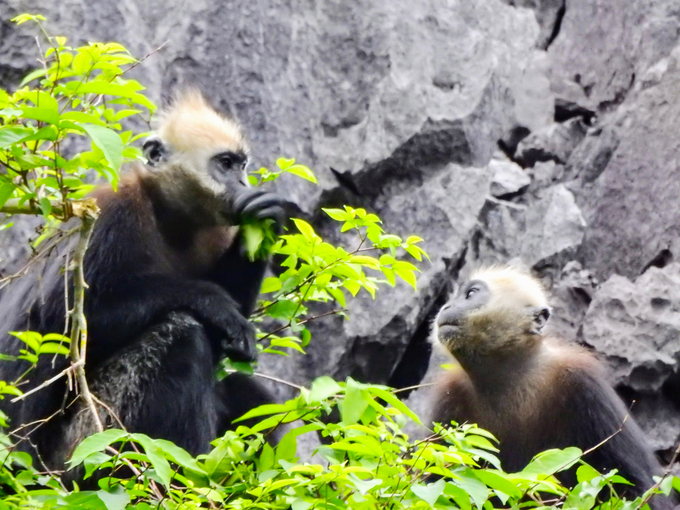
The Cat Ba langur is one of four endemic primate species in Vietnam. Photo: Huy Cam.
According to Mr. Pham Van Phuc, since 2000, Cat Ba National Park and the local government have had many solutions to protect and develop the langur herd, such as disseminating and mobilizing hunters not to go into the forest to illegally hunt wildlife, increasing patrols, and strictly handling violations. Thus, the langur herd has been protected.
Currently, there are 12 ranger stations with more than 50 forest rangers, all of whom participate in disseminating forest protection, preventing forest fires, protecting world natural heritage and biosphere reserves, and monitoring biodiversity, including the langur herd.
Along with that, there are three groups to protect langurs; each group has 5–6 people with the core force of reputable, responsible people who are knowledgeable about langurs, including those who used to rely on forests.
The langur protection groups include Gia Luan commune, Hai Son (Tran Chau) commune, and Viet Hai commune. They go to the forest 1-2 times a week, are responsible and enthusiastic people in protecting the forest, are remunerated by the Cat Ba langur protection project, and have been maintained for more than 10 years.
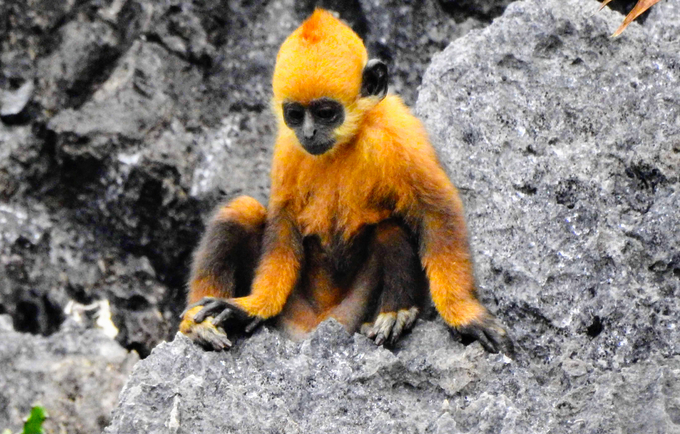
At birth, young langurs have bright orange-yellow fur. From the 4th month onwards, the fur color on their bodies begins to gradually turn black. Photo: Huy Cam.
The Cat Ba langur is one of four endemic primate species in Vietnam that is in extremely endangered condition. At birth, young langurs have bright orange-yellow fur. From the 4th month onwards, the fur color on their bodies begins to gradually turn black, but from the shoulders to the top of the head, it remains bright yellow.
Cat Ba langurs have a long childhood and are cared for and taught survival skills by adult individuals in the herd. Langurs can live for a maximum of 25-30 years old, give birth once from 4 to 6 years old, and the interval between births is about 2 years.
Adult langurs have a body length of about 47–53 cm and a tail length of about 85–90 cm. Langurs live in herds like family units, with the male head playing a role in leading the herd to find food, warning threats to the herd, and finding a place to sleep.
Cat Ba langurs mainly eat tree leaves, a few flowers, and forest fruits, and can especially eat Gelsemium elegans and Strychnos nux-vomica. The langur population has declined sharply since the 1960s due to hunting and the process of natural selection. Within 40 years, from 1960 to 1990, Cat Ba langurs lost about 98% of their population size.

Langurs live in herds like family units, with the male head playing a role in leading the herd to find food and warning threats. Photo: Huy Cam.
Previously, the Cat Ba langur population thrived with an estimated number of 2,500–3,000 individuals. However, due to hunting and conflicts to take over the herd that made the winning male langurs kill young heads, the next generation reduced, causing the number of langurs to plummet from thousands to less than 40 in 2000.
Cat Ba National Park is one of the world's biosphere reserves and a special-use forest with rich biodiversity, as well as one of the national parks with important island ecosystems in Vietnam.
Cat Ba National Park has an area of more than 17,300 hectares and highly increasing biodiversity with many endemic and rare species. The Park is home to over 4,000 species of animals and plants, including many rare and endemic species such as Cat Ba white-headed langur, black squirrel, chamois, rhesus monkey, and Cat Ba leopard gecko.
The Cat Ba langur conservation project has been implemented since 2000, when there were only nearly 50 langurs left. Over the years, the project, Cat Ba National Park, and people have tried to minimize the impact to ensure the living environment and avoid the risk of extinction of the langur species.
Translated by Thu Huyen

(VAN) The 4th technical meeting advanced Vietnam–Australia policy cooperation on ecological agriculture, climate change adaptation, and post-disaster recovery.

(VAN) Technological innovation for green growth helps Vietnam reduce emissions, enhance competitiveness, and meet its net-zero emissions target by 2050.
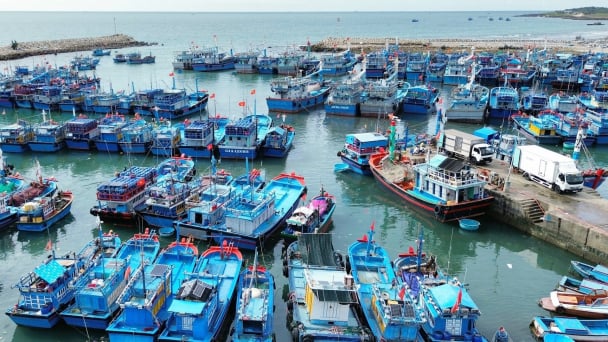
(VAN) Deputy Minister Phung Duc Tien has called on the South Central and Central Highlands Representative Office of the Vietnam Agriculture and Nature Newspaper to further strengthen communication to combat IUU fishing.

(VAN) Recently, in Bangkok, Thailand, the working delegation from Vietnam's Ministry of Agriculture and Environment, led by Deputy Minister Le Minh Ngan, has visited and worked with Thailand's Ministry of Natural Resources and Environment.

(VAN) On the afternoon of June 28, the ceremony to receive the certificate recognizing Lang Son as a UNESCO Global Geopark was held in Lang Son city.
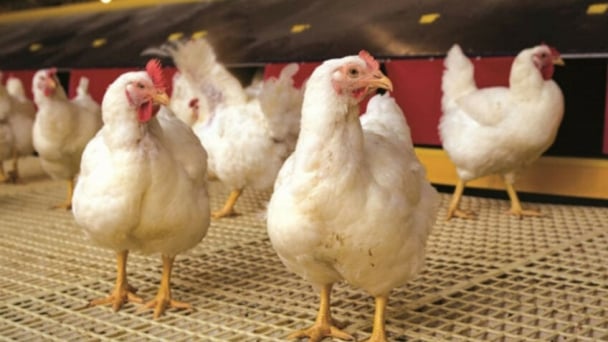
(VAN) Brazil is officially free from highly pathogenic avian influenza (HPAI) in commercial poultry farms, having completed the 28-day sanitary standstill.

(VAN) ECOEYE Korea expressed interest in cooperating with Vietnam in transferring advanced recycling technologies and developing the carbon market.